
Sparkling wine is a wine with significant levels of carbon dioxide in it, making it fizzy. While the phrase commonly refers to champagne, European Union countries legally reserve that term for products exclusively produced in the Champagne region of France. Sparkling wine is usually either white or rosé, but there are examples of red sparkling wines such as the Italian Brachetto, Bonarda and Lambrusco, and the Australian sparkling Shiraz. The sweetness of sparkling wine can range from very dry brut styles to sweeter doux varieties.

Pinot noir is a red-wine grape variety of the species Vitis vinifera. The name may also refer to wines created predominantly from pinot noir grapes. The name is derived from the French words for pine and black. The word pine alludes to the grape variety having tightly clustered, pinecone–shaped bunches of fruit.

Pinot blanc is a white wine grape. It is a point genetic mutation of Pinot noir. Pinot noir is genetically unstable and will occasionally experience a point mutation in which a vine bears all black fruit except for one cane which produces white fruit.

Chenin blanc is a white wine grape variety from the Loire Valley of France. Its high acidity means it can be used to make varieties from sparkling wines to well-balanced dessert wines, although it can produce very bland, neutral wines if the vine's natural vigor is not controlled. Outside the Loire, it is found in most of the New World wine regions; it is the most widely planted variety in South Africa, where it was historically also known as Steen. The grape may have been one of the first to be grown in South Africa by Jan van Riebeeck in 1655, or it may have come to that country with Huguenots fleeing France after the revocation of the Edict of Nantes in 1685. Chenin blanc was often misidentified in Australia, as well, so tracing its early history in the country is not easy. It may have been introduced in James Busby's collection of 1832, but C. Waterhouse was growing Steen at Highercombe in Houghton, South Australia, by 1862.

Trousseau or Trousseau Noir, also known as Bastardo and Merenzao, is an old variety of red wine grape originating in eastern France. It is grown in small amounts in many parts of Western Europe; the largest plantations are today found in Portugal, where most famously it is used in port wine. It makes deep cherry red wines with high alcohol and high, sour candy acidity, and flavours of red berry fruits, often complemented - depending on production - by a jerky nose and an organic, mossy minerality.

A rosé is a type of wine that incorporates some of the color from the grape skins, but not enough to qualify it as a red wine. It may be the oldest known type of wine, as it is the most straightforward to make with the skin contact method. The pink color can range from a pale "onionskin" orange to a vivid near-purple, depending on the grape varieties used and winemaking techniques. Usually, the wine is labelled rosé in French, Portuguese, and English-speaking countries, rosado in Spanish, or rosato in Italian.

Aligoté is a white grape used to make dry white wines, especially in the Burgundy region of France where it was first recorded in the 18th century. Since it is tolerant to cold, this variety is also cultivated in Eastern European countries. In 2004, it was the 22nd most planted vine variety in the world at 45,000 hectares.
Arbois or Arbois Blanc is a white French wine grape variety planted primarily in the Loire regions. Despite being a minor grape, in the late 20th century it was the third most widely planted grape variety in the Loir-et-Cher département which includes the winemaking areas of Cheverny, Cour-Cheverny, Montrichard, Oisly, Saint-Romain-sur-Cher, Valençay as well as vineyards that make wines under the Touraine AOC, Cremant de Loire AOC and Vin de Pays du Loir et Cher. By 2004 acreage had steadily declined to around 750 acres. It is still a permitted grape variety in the Appellation d'origine contrôlée (AOC) regions of Cheverny AOC, Valençay AOC and Vouvray AOC.

Jura wine is French wine produced in the Jura département. Located between Burgundy and Switzerland, this cool climate wine region produces wines with some similarity to Burgundy and Swiss wine. Jura wines are distinctive and unusual wines, the most famous being vin jaune, which is made by a similar process to Sherry, developing under a flor-like strain of yeast. This is made from the local Savagnin grape variety. Other grape varieties include Poulsard, Trousseau, and Chardonnay. Other wine styles found in Jura includes a vin de paille made from Chardonnay, Poulsard and Savagnin, a sparkling Crémant du Jura made from slightly unripe Chardonnay grapes, and a vin de liqueur known as Macvin du Jura made by adding marc to halt fermentation. The renowned French chemist and biologist Louis Pasteur was born and raised in the Jura region and owned a vineyard near Arbois.
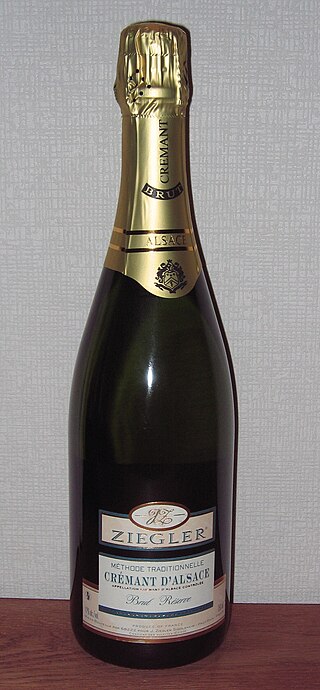
Crémant d'Alsace is an Appellation d'Origine Contrôlée for sparkling wines made in the Alsace wine region of France. Produced since 1900, the Crémant d'Alsace AOC was recognized in 1976 by the INAO and the designation Crémant regulated by the European Parliament in 1996.
Pineau d'Aunis is a red French wine grape variety that is grown primarily in the Loire Valley around Anjou and Touraine.

Mondeuse noire is a red French wine grape variety that is grown primarily in the Savoy region of eastern France. The grape can also be found in Argentina, Australia, California, Switzerland and Sicily. Plantings of Mondeuse noire was hit hard during the phylloxera epidemic of the mid to late 19th century which nearly wiped out the vine from eastern France. While the grape recovered slightly in the 20th century, French plantations of Mondeuse noire fell sharply in the 1970s, with just over 200 hectares left in France in 2000. In the early 21st century, it seems the variety has increased somewhat in popularity, as it can give good wines if the planting site is chosen carefully.
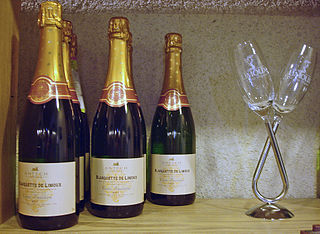
Limoux wine is produced around the city of Limoux in Languedoc in southwestern France. Limoux wine is produced under four Appellation d'origine contrôlée (AOC) designations: Blanquette de Limoux, Blanquette méthode ancestrale, Crémant de Limoux and Limoux, the first three of which are sparkling wines and dominate the production around Limoux. The main grape of the region is the Mauzac, locally known as Blanquette, followed by Chardonnay and Chenin blanc. In 2005, the Limoux AOC was created to include red wine production consisting of mostly Merlot. Wine historians believe that the world's first sparkling wine was produced in this region in 1531, by the monks at the abbey in Saint-Hilaire.
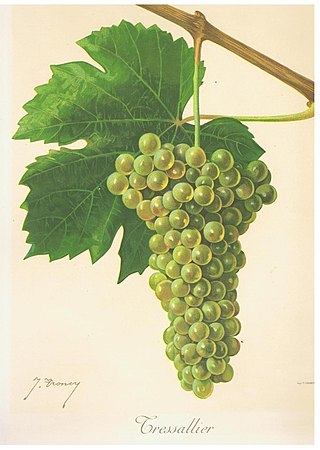
Sacy is a white wine grape grown primarily in the central and northeastern France within the Yonne and Allier départments.

The Loire Valley wine region includes the French wine regions situated along the river Loire from the Muscadet region near the city of Nantes on the Atlantic coast to the region of Sancerre and Pouilly-Fumé just southeast of the city of Orléans in north central France. In between are the regions of Anjou wine, Saumur, Bourgueil, Chinon, and Vouvray. The Loire Valley itself follows the river through the Loire department to the river's origins in the Cévennes but the majority of the wine production takes place in the regions noted above. The area includes 87 appellations under the Appellation d'origine contrôlée (AOC) and Indication Géographique Protégée (IGP) systems. While the majority of production is white wine from the Chenin blanc, Sauvignon blanc and Melon de Bourgogne grapes, there are red wines made from Cabernet franc. In addition to still wines, rosé, sparkling and dessert wines are also produced. With Crémant production throughout the Loire, it is the second largest sparkling wine producer in France after Champagne. Among these different wine styles, Loire wines tend to exhibit characteristic fruitiness with fresh, crisp flavors-especially in their youth. The Loire Valley has a long history of winemaking dating back to the 1st century. In the High Middle Ages, the wines of the Loire Valley were the most esteemed wines in England and France, even more prized than those from Bordeaux.

Frédéric Lornet is a wine producer who owns and runs the Abbaye de la Boutière in Montigny-lès-Arsures; a small village just outside Arbois in the Franche-Comté / Jura region of France.
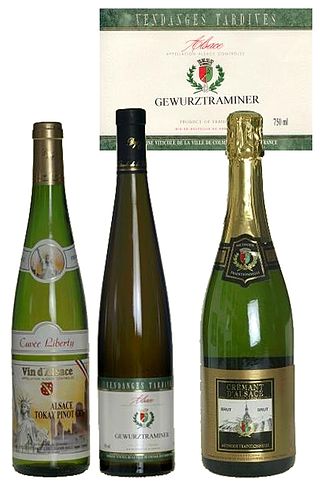
The wine region of Alsace produces wines under three different Appellations d'Origine Contrôlées (AOCs): Alsace AOC for white, rosé and red wines, Alsace Grand Cru AOC for white wines from certain classified vineyards and Crémant d'Alsace AOC for sparkling wines. This region is the only French wine region allowed to label its wines based on variety.
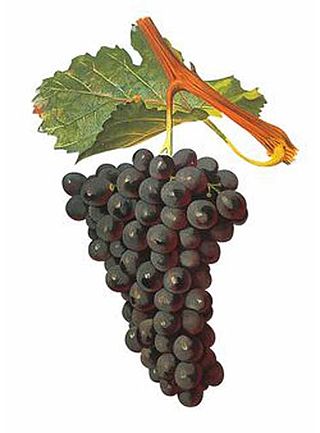
Terret is an ancient Vitis vinifera vine that, like the parent Pinot vine of Pinot noir's history, mutated over the course of thousands of years into grape varieties of several color. Originating in the Languedoc-Roussillon wine of southern France, the descendants of Terret now include the red wine variety Terret noir, the white Terret blanc and the light-skinned Terret gris.
Gueuche noir is a red French wine grape variety that has been historically grown in the Franche-Comté of eastern France but is now close to being extinct. Though its exact relationship has not yet been determined by DNA analysis, ampelographers believe that the grape variety is closely related to the Hunnic grape Gouais blanc which is notable for being the mother vine to several grape varieties including Chardonnay and Gamay. There also might be a relationship between Gueuche noir and the Jura wine grape Enfariné noir.
Seyval noir is a red hybrid grape variety that was created in the late 19th century by French horticulturalist Bertille Seyve and his father-in-law Victor Villard from a crossing of two Seibel grapes. The pair used the same two variety to create the white wine grape Seyval blanc making the two siblings rather than color mutations of one or the other. The name Seyval comes from a combination of the two men's names.




















